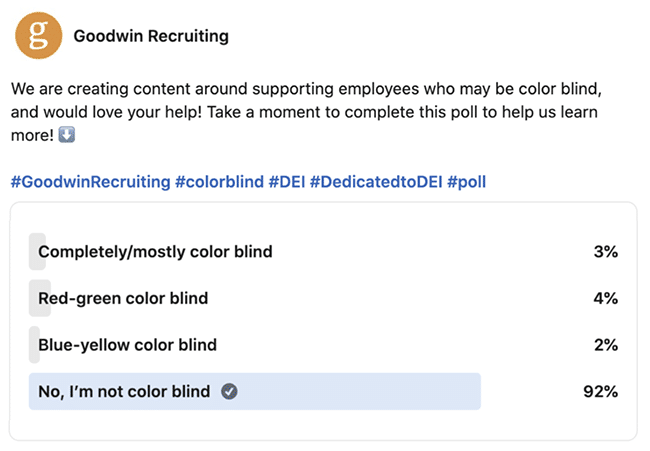How to Support Colorblind Employees (and Customers!)
Goodwin Recruiting | Diversity & Inclusion, Hiring Advice, Leadership | October 30, 2023

The more we learn about diversity, equity, and inclusion (DEI), the more we realize how much there is to know! This is especially true when striving to identify, acknowledge, and support groups of people who deserve to be understood and assisted in a truly inclusive company culture.
One segment of our population that is increasingly recognized by DEI-conscious employers is people who are affected by colorblindness, which is formally referred to as color vision deficiency (CVD). For any 18th century history buffs out there, colorblindness is also known as Daltonism, named after scientist John Dalton, who was affected by red-green colorblindness. One of his first scientific papers was titled “Extraordinary facts relating to the vision of colours” – released in 1793!
Read on to explore the prevalence of color vision deficiency, how it impacts people in their jobs, and how employers can take action to support affected employees and customers and improve their experiences with the company and brand.
A few statistics and facts about colorblindness
- Worldwide, approximately 300 million people have colorblindness.
- 1 in 12 males is colorblind (8% of the global population).
- 1 in 200 females has the condition (0.5% of the global population).
- Red-green colorblindness is the most common form (99%): 75% of people with red-green colorblindness have trouble with green perception and 24% with red perception.
- Blue-yellow colorblindness and total colorblindness (seeing only shades of gray) are very rare.
- Babies are born colorblind! Color vision is typically fully developed by the age of six months.
Colorblindness is more common in males because the genes responsible for the most common inherited condition (red-green) are on the X chromosome. Males have one X chromosome. Females have two, and a functional gene on one of the two can compensate for loss on the other; however, there are other ways females can inherit color vision deficiency.
Three types of color vision deficiency
The National Eye Institute (NEI), part of the federal government’s National Institutes of Health (NIH), identifies that the three most common types of colorblindness are genetic, passed down from parents to their children:
- As noted above, the most common type makes it hard to tell the difference between red and green.
- Another type makes blue and yellow look the same.
- In rare cases, people have complete color vision deficiency, which means they don’t see color at all.
Our own survey results align with global statistics
As part of our initiative to expand and improve our DEI initiative, Goodwin Recruiting polled our LinkedIn audience on the topic of colorblindness. Our findings closely align with the global statistics noted above, collectively showing that about 9% of our survey respondents are either red-green colorblind, blue-yellow colorblind, or completely/mostly colorblind…

Assist colorblind employees through an organic approach
Colorblind people are often discreet about their color vision deficiency, but based on statistics, any business with more than 12 male employees is likely to have at least one male on staff who is colorblind. The same goes for a business with 200 female employees – at least one is likely affected.
These employees are regularly challenged in fully accessing information from their leadership, managers, and teams. In the largest known study of its kind, EnChroma, creator of glasses for colorblindness, illuminated the obstacles that workers with colorblindness face at work. Key findings showed that:
- Nine of 10 people with CVD stated that correctly identifying colors plays a role in their job.
- 75% reported that being colorblind slows them down at work.
- 65% have trouble interpreting color-coded materials.
- More than 20% can’t perform certain work that requires accurate color identification.
People with normal vision don’t know what it’s like to not have the ability to distinguish different colors and color combinations. Given how important color is in delivering clarity in various forms of communication, it’s crystal clear that employees and customers who are colorblind need active support and a much deeper level of understanding from today’s companies.
Following are four ways employers can embrace colorblindness on its own or as part of a DEI initiative.
1. Educate your organization
Leadership, managers, creative teams, and employees should be aware of the commonness of colorblindness and its impacts, not only on company employees but also on customers. An educational effort can be pursued in several ways, such as circulating informative articles and fact sheets, creating training sessions or videos about colorblindness, or creating a group for employees impacted by CVD and team members who want to learn from them. Encourage leaders and managers to create and support these initiatives – and give employees the opportunity to run with good ideas.
As an example, Cigna is supporting employees with collaboration from people across its organization. They have a colorblindness intranet resource page with an interactive test (giving perspective into what someone who is colorblind may see), as well as an employee toolkit for creating colorblind-friendly documents. Cigna is also creating learning and training programming around colorblindness from a health equity standpoint, working on ways to include colorblindness in the content review process, and creating programming that focuses on colorblind-friendly themes and colors.
2. Review your existing materials
Colorblind employees struggle with many informational sources, ranging from company websites to business documents, presentations, photos, spreadsheets, charts, and more. Rather than just using colors to convey a message, it’s helpful to incorporate text, labels, or patterns to help people accurately differentiate and visualize information. In other words, it’s important to recognize that color is not the only component to consider. Clear labeling, the use of text and symbols, and typefaces and sizes all matter, as does how they are presented in the full picture. Here are some great guidelines and techniques:
- 8 Ways to Design a Colorblind-Friendly Website
- How to Use Colorblind-Friendly Palettes to Make Your Charts Accessible
- 5 Tips on Designing Colorblind-Friendly Visualizations
EnChroma’s Color Accessibility Program encourages employers to use simple guidelines to adapt work materials and workplace environments to accommodate red-green color vision deficient staff, such as:
- Avoid using colors containing red or green in presentations, spreadsheets, graphs, safety signage, operational controls, and instructional and other materials.
- Label colors in workplace materials to facilitate correct color identification for colorblind staff.
- Consider making reasonable workplace accommodation assistive tools available to colorblind employees, like simulators and apps for Android and iOS phones or contact lenses and glasses for colorblindness.
3. Improve your digital communications platforms
Digital platforms are critical venues for companies in communicating with employees and customers – yet websites, intranets, social media pages, and other online platforms may have issues that affect the experiences of colorblind users.
In fact, color vision deficiency is common enough that it is addressed in the Web Content Accessibility Guidelines (WCAG), published by the World Wide Web Consortium (W3C). The WCAG gives designers and developers success criteria for making content more accessible. On a related note, Mark Zuckerberg, chairman and CEO of Meta, is red-green colorblind. The color he sees best is blue, which is why the color blue dominates Facebook’s website and mobile app.
Here at Goodwin Recruiting, we added an accessibility icon to our website that lets users choose the contrast of colors that’s easiest and most helpful for them in viewing content on our web pages…
![]()
4. Encourage transparent communication and conduct employee surveys
As you work to raise awareness of colorblindness within your organization, those affected by CVD will become more comfortable in talking about the issues they experience – and more likely to ask for help when they need it. They may also provide valuable input and suggestions on how to improve the way specific information is presented. Let your people know it’s okay to ask for clarification if they’re unsure of task-related colors or labels. Better yet, let them review content before it is published or introduced to a broader team of employees.
Conduct surveys among employees. Start by asking for feedback on your company colors, your website, packaging, and other company and branding methods and materials. Consult resources like those linked earlier in this article for examples, guidelines, and best practices, or engage your creative team and graphic designers or creative agency to help you create inclusive designs. Through ongoing employee surveys, you can find out what’s working and what’s not in visual and textual communications. And keep in mind how important it is to take employee feedback into consideration and make adjustments to resolve issues that are raised.
Strike a relationship with a DEI-conscious talent recruiter
Supporting employees who are colorblind is a great step in creating a more inclusive workplace. And the benefits are even greater when your efforts create a more inclusive experience for customers with CVD through your website and other digital communications platforms.
If you’re ready to partner with a recruiting firm that is dedicated to diversity, equity, and inclusion and its many facets, reach out to Goodwin Recruiting’s team of talent acquisition specialists today.
Additional Resources:
Share This Article






































